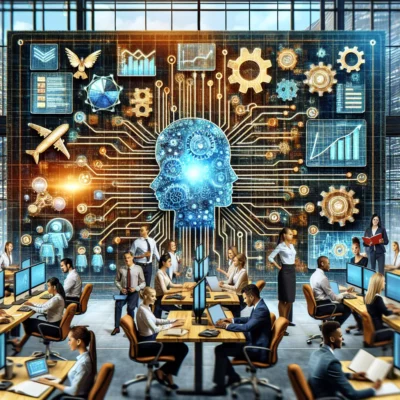In the dynamic world of workforce management, businesses are constantly seeking ways to optimize their operations and improve efficiency. The advent of Artificial Intelligence (AI) has introduced groundbreaking solutions that are transforming how organizations manage their workforce. From predicting staffing needs to enhancing resource allocation, AI-powered solutions are reshaping the landscape of workforce management.
Understanding AI-Powered Workforce Solutions
AI-powered solutions utilize advanced algorithms and machine learning to streamline workforce management processes. These technologies analyze vast amounts of data to provide insights that help businesses make informed decisions. By leveraging AI, organizations can optimize scheduling, enhance resource allocation, and ultimately improve productivity.
Benefits of AI in Workforce Management
- Optimized Scheduling: AI-driven systems can predict staffing needs with remarkable accuracy. By analyzing historical data and identifying patterns, these systems can forecast demand and adjust schedules accordingly, ensuring that the right number of employees is available at the right time.
- Resource Allocation: AI can analyze resource usage patterns to optimize allocation. This minimizes waste and maximizes efficiency by ensuring that resources are used where they are most needed.
- Improved Decision-Making: With AI, businesses can make data-driven decisions that enhance overall operations. The ability to process and analyze large datasets quickly allows for more strategic planning and execution.
Traditional Methods vs. AI-Driven Approaches
Traditional workforce management methods often rely on manual processes and static scheduling, which can be inefficient and error-prone. In contrast, AI-driven approaches offer dynamic and adaptive solutions that respond to real-time data, providing a more agile and responsive workforce management system.
AI-Driven Scheduling: A Game Changer
AI algorithms have revolutionized scheduling by predicting staffing needs based on historical data. This predictive capability allows businesses to anticipate demand fluctuations and adjust schedules proactively. Machine learning further enhances this process by continuously learning from new data and refining scheduling models.
Real-Time Schedule Adjustments
Machine learning enables AI systems to adjust schedules in real-time, accommodating unexpected changes such as employee absences or sudden demand spikes. This flexibility ensures that businesses maintain optimal staffing levels without overstaffing or understaffing.
Industry Examples
Several industries are already reaping the benefits of AI-driven scheduling:
- Retail: AI helps retailers manage peak shopping times by predicting customer footfall and adjusting staff schedules accordingly.
- Healthcare: Hospitals use AI to forecast patient admissions and optimize nurse and doctor shifts, improving patient care and reducing wait times.
- Manufacturing: AI systems predict production demands, allowing manufacturers to allocate labor efficiently and reduce downtime.
Enhancing Resource Allocation with AI
AI’s ability to analyze resource usage patterns is a game-changer in resource management. By identifying inefficiencies and optimizing allocation, AI helps businesses minimize waste and maximize efficiency.
Minimizing Waste and Maximizing Efficiency
AI systems can identify underutilized resources and suggest reallocations to areas with higher demand. This not only reduces waste but also ensures that resources are used effectively, leading to cost savings and improved operational efficiency.
Successful AI Implementation
Case studies highlight the success of AI in resource management:
- Logistics: AI optimizes delivery routes and fleet management, reducing fuel consumption and improving delivery times.
- Energy: AI systems manage energy consumption in large facilities, optimizing heating, cooling, and lighting to reduce costs and environmental impact.
Overcoming Challenges in AI Integration
While AI offers numerous benefits, integrating these technologies into existing systems can present challenges. Common obstacles include resistance to change, lack of expertise, and concerns about job displacement.
Strategies for Overcoming Resistance
- Education and Training: Providing employees with training on AI technologies and their benefits can help alleviate fears and build confidence in new systems.
- Change Management: Implementing a structured change management process can facilitate smoother transitions and encourage employee buy-in.
- Upskilling: Investing in upskilling programs ensures that employees are equipped with the skills needed to work alongside AI systems, enhancing their roles rather than replacing them.
The Future of Workforce Management with AI
As AI technology continues to evolve, the future of workforce management looks promising. Businesses that embrace AI innovations will be better positioned to adapt to changing market conditions and maintain a competitive edge.
Future Trends and Advancements
- Enhanced Predictive Analytics: AI advancements will lead to even more accurate predictive analytics, enabling businesses to anticipate trends and make proactive decisions.
- Integration with IoT: The integration of AI with the Internet of Things (IoT) will provide real-time data from connected devices, further enhancing scheduling and resource management.
- Personalized Employee Experiences: AI will enable personalized work experiences by tailoring schedules and tasks to individual preferences and strengths, improving job satisfaction and productivity.
Staying Ahead with AI Innovations
To stay ahead in the rapidly evolving business landscape, organizations must embrace AI innovations. By investing in AI technologies and fostering a culture of continuous learning, businesses can unlock new levels of efficiency and productivity.
In the ever-changing world of workforce management, AI is not just a tool—it’s a transformative force that holds the key to future success. By harnessing the power of AI, businesses can revolutionize their operations, optimize their workforce, and thrive in an increasingly competitive market.
